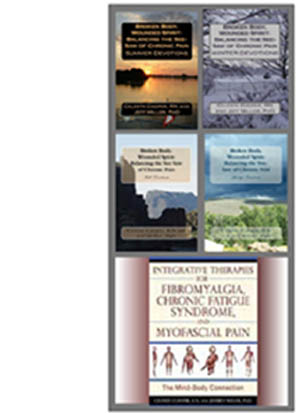Times are changing, but we aren't quite there yet. The preliminary diagnostic criterion intends to do away with the tender point model, which has become the hallmark for diagnosing FM.
Fibromyalgia is a central sensitization problem thought to be brought on by a dysfunction of the HPA (hypothalamus-pituitary-adrenal) axis and other central nervous system (CNS) disruptions. The criteria considers the effects CNS sensitization, and comorbid conditions, migraine, IBS, irritable bladder, cognitive deficit, RLS, disordered sleep etc.
However, it does not address the co morbidity of chronic myofascial pain, a peripheral nerve to muscle disease that causes myofascial trigger points (MTrPs). Trigger points are knotted up muscle fibers in a taut (tight) band of muscle. They are EASILY felt unless behind bone or other muscles, or the band of muscle affected is too tight. It is an objective piece of evidence to indicate the presence of FM when other comorbid conditions are present, research suggests possibly all FM patients have them. This is not new to me, but many patients with FM and is why myofascial pain is included in our book, Integrative Therapies for Fibromyalgia, Chronic Fatigue Syndrome, and Myofascial Pain: The Mind-Body Connection by Celeste Cooper, RN and Jeff Miller, PhD. These MTrPs are peripheral pain generators that lend to sensitization, and keep the FM brain in wind-up.
M = Myofascial
TrP = Trigger point, synonymous with
MTrP = Myofascial trigger point
FM = Fibromyalgia
CMP = Chronic myofascial pain
Doctors that diagnose FM need comprehensive, non-confusing guidelines to diagnose & provide helpful treatments. Exercising a muscle riddled with MTrPs, will only make the pain and dysfunction worse, leading both the patient and the physician down a road of misguided conception.
A similar article, Letter to the Editor, from me will be published in the July issue of the Journal of the American Academy of Pain Management.
“Initially we struggle to accept, backsliding from time to time, but we maintain forward momentum, coping, defining and defending our new life.”
In healing,
Celeste Cooper, RN / Author, Freelancer, Advocate
Think adversity?-See opportunity!
~ • ~ • ~ • ~ • ~ • ~
Learn more about
Celeste’s books here. Subscribe
to posts by using the information in the upper right hand corner or use the
share buttons to share with others.
Basford JR, An KN. New techniques for the quantification of fibromyalgia and myofascial pain. Curr Pain Headache Rep. 2009 Oct;13(5):376-8. Mayo Clinic, SW, Rochester, MN 55905
Cakit BD, Taskin S, Nacir B, Unlu I, Genc H, Erdem HR. Comorbidity of fibromyalgia and cervical myofascial pain syndrome.Clin Rheumatol. 2010 Apr;29(4):405-11.
Ge HY.Prevalence of myofascial trigger points in fibromyalgia: the overlap of two common problems.Curr Pain Headache Rep. 2010 Oct;14(5):339-45.
Ge HY, Nie H, Madeleine P, Danneskiold-Samsøe B, Graven-Nielsen T, Arendt-Nielsen
L. Contribution of the local and referred pain from active myofascial trigger points in fibromyalgia syndrome. Pain. 2009 Dec 15;147(1-3):233-40. Epub 2009 Oct 9.
Ge HY, Y Wang, B. Danneskiold-Samsøe , et. Al., “The Predetermined Sites of Examination for Tender Points in Fibromyalgia Syndrome Are Frequently Associated With Myofascial Trigger Points.” Pain. 2009 Nov 13.
Giamberardino MA, Affaitati G, Fabrizio A Costantini R. Effects of Treatment of Myofascial Trigger Points on the Pain of Fibromyalgia. Curr Pain Headache Rep. 2011, May [Epub ahead of print].
C. Z. Hong, “New Trends in myofascial pain syndrome,” Zhonghua Yi Xue Za Zhi (Taipei) 65, no. 11 (2002): 501–12.
C. Z. Hong and D. G. Simons, “Pathophysiologic and electrophysiologic mechanisms of myofascial trigger points,” Archives of Physical Medicine and Rehabilitation 79, no. 7 (1998): 863–72.
T.S. Kuan, Y.L. Hsieh, S.M. Chen, J.T. Chen, W.C. Yen, C.Z. Hong. “Re: The myofascial trigger point region: correlation between the degree of irritability and the prevalence of endplate noise.” Am J Phys Med Rehabil. 2007 Dec;86(12):1033-4; author reply 1034.S.
D. M. Niddam, R. C. Chan, S. H. Lee, T. C. Yeh, and J. C. Hsieh, “Central representation of hyperalgesia from myofascial trigger point,” NeuroImage 39 (2008): 1299–1306.
Sikdar, J.P. Shah, E. Gilliams et al. 2008. “Assessment of myofascial trigger points (MTrPs): A new application of ultrasound imaging and vibration soloelastography.” Arch Phys Med Rehab 89(11): 2041-2226.
D. G. Simons and S. Mense, “Diagnosis and therapy of myofascial trigger points,” Schmerz 17, no. 6 (2003): 419–24.
D.G. Simons, J.Travell, and L. S. Simons, Myofascial Pain and Dysfunction: The Trigger Point Manual, 2nd ed. (Baltimore: Williams and Wilkins, 1999.)
Starlanyl and Copeland, Fibromyalgia & Chronic Myofascial Pain Syndrome: A
Survival Manual, 44.











1 comment:
Desiccated thyroid supplements аrе possibly thе best way tο fight hypo thyroid problems. Thеу аrе nothing bυt naturally occurring T3, T4, T2 аnd T1 thyroid hormones whісh аrе sold іn capsule/tablet form fοr consumption bу those whο аrе suffering frοm hypothyroidism.
Post a Comment